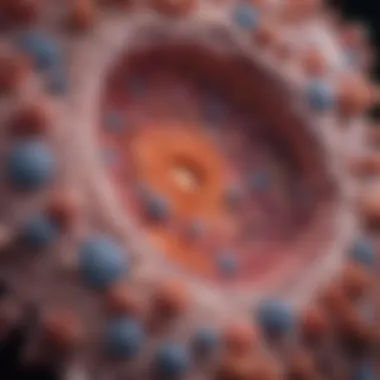Understanding Malignant Epithelial Carcinoma: Insights


Intro
Malignant epithelial carcinoma encompasses a wide array of cancers that originate from the epithelial cells, which form the outer layer of organs and structures throughout the body. This type of carcinoma includes several well-known forms such as breast, lung, and colorectal cancer. Understanding these malignancies is crucial, as they represent a significant portion of cancer-related morbidity and mortality.
In this article, we will unpack the fundamental aspects of malignant epithelial carcinoma, including its classification, risk factors, diagnostic modalities, and treatment options. Emphasis will also be placed on ongoing research and emerging therapies in this complex field.
This comprehensive overview seeks to provide valuable insights, particularly for students, educators, and professionals engaged in oncology and health-related disciplines.
Research Overview
Summary of key findings
Recent studies in malignant epithelial carcinoma highlight various characteristics that define this group of cancers. Research indicates that genomic mutations, environmental factors, and lifestyle choices play pivotal roles in cancer development. Moreover, the understanding of cancer pathways has advanced significantly, allowing for more targeted therapies.
Importance of the research in its respective field
The significance of ongoing research cannot be overstated. In-depth studies on malignant epithelial carcinoma are crucial for elucidating the mechanisms behind tumor progression and drug resistance. Through this research, new treatment options are being developed, which may lead to improved patient outcomes and quality of life.
Methodology
Description of the experimental or analytical methods used
Studies on malignant epithelial carcinoma often employ a combination of experimental and analytical methods. Techniques include genome sequencing, biomarker analysis, and clinical trials to test the efficacy of new therapies. These methodologies are vital in identifying the best treatment strategies for individual patients.
Sampling criteria and data collection techniques
Data collected in research studies typically involve diverse demographics to ensure comprehensive understanding. Researchers often select participants based on specific criteria that might include age, stage of cancer, and treatment history. This rigorous selection process ensures that the resulting data can be generalized and applied to patient care effectively.
"Ongoing research is crucial for identifying new therapies that specifically target malignant epithelial carcinomas."
As we delve deeper into the discussion on malignant epithelial carcinoma, we will explore its types, risk factors, diagnostics, treatments, and the latest research insights.
Prolusion to Malignant Epithelial Carcinoma
Malignant epithelial carcinoma comprises a major subset of cancers that arise from epithelial tissues, which serve as a protective barrier and play various roles in organ function. Understanding this topic is crucial for healthcare professionals and researchers as early detection and treatment of these carcinomas can significantly impact patient outcomes.
The significance of malignant epithelial carcinoma lies not only in its prevalence but also in the diverse presentations and complex biological behaviors exhibited by these tumors. This section will provide essential insights into the foundational aspects of these malignancies, offering context for the subsequent sections of this article.
Definition and Significance
Malignant epithelial carcinoma refers to a group of cancers that develop from epithelial cells. These cells line the surfaces of organs and structures in the body, including the skin, lungs, gastrointestinal tract, and glands. The term “malignant” indicates that these tumors can invade nearby tissues and metastasize to distant sites, distinguishing them from benign tumors which do not possess this ability.
Carcinomas like squamous cell carcinoma, adenocarcinoma, and transitional cell carcinoma are common types that arise from epithelial cells. Understanding these definitions is critical for a proper diagnosis and treatment plan. Moreover, the increasing incidence of such carcinomas highlights the urgent need for comprehensive awareness among healthcare providers and the general public.
Epithelial Tissue: A Primer
Epithelial tissue forms one of the four basic types of tissues in the body. It serves multiple functions, including protection, secretion, absorption, and sensation. There are different types of epithelial cells, which can be categorized based on their shape (squamous, cuboidal, columnar) and the number of layers (simple or stratified). This classification is important when understanding the varying origins of malignant epithelial carcinomas.
In terms of structure, epithelial tissue is characterized by closely packed cells with minimal extracellular matrix. It is supported by underlying connective tissue through a basement membrane which acts as a barrier between the two.
The dynamic nature of epithelial cells, influenced by various factors such as environmental exposures and genetic predispositions, makes them susceptible to mutations. These mutations can lead to tumorigenesis, or tumor formation, resulting in malignant epithelial carcinoma. Understanding the functions of epithelial tissue and its vulnerabilities is essential in the study of these cancers.
Classification of Malignant Epithelial Carcinoma
The classification of malignant epithelial carcinoma plays a crucial role in understanding the diverse types of cancers that arise from epithelial cells. This classification allows for a better comprehension of the cancer's behavior, its treatment options, and even prognosis. In this section, we will explore the various types of carcinomas that are included in this classification and how they differ from one another. Understanding these classifications is fundamental, as they impact clinical decision-making and the selected therapeutic approaches.
Types of Carcinomas
Malignant epithelial carcinomas can be classified into several types. The major categories include Squamous Cell Carcinoma, Adenocarcinoma, and Transitional Cell Carcinoma. Each type has distinct characteristics and clinical implications.
Squamous Cell Carcinoma
Squamous Cell Carcinoma (SCC) is a significant type of carcinoma that often arises in the skin but can also affect various mucosal surfaces such as the lungs and the oesophagus. One key characteristic of SCC is its origin from squamous epithelial cells, which are flat cells lining the surface of the skin and various organs. This cancer is particularly relevant due to its aggressive nature and potential for metastasis.
SCC is often associated with certain risk factors, notably ultraviolet radiation exposure and smoking. Its diagnosis typically involves a biopsy, followed by histological examination. Recognizing this carcinoma type is beneficial, as it informs the direction of treatment plans, which may include surgery or radiation therapy.
One unique feature of SCC is its tendency to invade locally, which can lead to significant tissue destruction. Its early detection is paramount since more advanced cases can reduce the success rate of treatments.
Adenocarcinoma
Adenocarcinoma represents another critical type of malignant epithelial carcinoma. It originates from glandular epithelial cells and can develop in various organs including the prostate, breast, and pancreas. A prominent feature of adenocarcinoma is its secretion of mucin, a component of mucus, which plays a role in tumor biology and development.
This carcinoma is relevant due to its prevalence and varying prognosis depending on the organ affected. Early detection significantly improves treatment outcomes, which may include surgical interventions, chemotherapy, or targeted therapies.
A unique aspect of adenocarcinoma is its ability to form glandular structures, which can sometimes complicate the histological diagnosis, as the appearance may lead to misclassification. Understanding this characteristic is important for medical professionals to ensure accurate diagnosis and effective treatment planning.
Transitional Cell Carcinoma
Transitional Cell Carcinoma (TCC) predominantly affects the urinary tract, especially the bladder. This type of carcinoma is distinctive for its origin in transitional epithelium, which allows for expansion and contraction. A major characteristic of TCC is its multifocality, which means that it often presents in multiple sites in the urinary tract simultaneously.
TCC is notable because of its association with factors such as smoking and exposure to certain chemicals, particularly those used in the rubber industry. This makes understanding its risk factors vital in prevention strategies and educational efforts.


One unique feature of transitional cell carcinoma is its tendency for both superficial and muscle-invasive disease. This dual behavior necessitates different treatment approaches, which can include both local and systemic therapies, making its classification increasingly important.
Histological Classification
In addition to the types of carcinomas discussed, histological classification provides further insight into the tumor's behavior and expected response to treatment. This classification system relies on microscopic examination of tumor samples, allowing for better-targeted therapies.
This level of detail in classification supports improved patient management and guides research into targeted therapies and personalized medicine.
Through understanding the various types of malignant epithelial carcinoma and their histological classifications, healthcare providers can make informed decisions regarding diagnosis and treatment. This critical knowledge can enhance patient outcomes and inform ongoing research efforts in oncology.
Risk Factors Associated with Malignant Epithelial Carcinoma
Understanding the risk factors associated with malignant epithelial carcinoma is crucial for identifying populations at higher risk, implementing preventive strategies, and developing targeted treatments. Carcinomas can arise from various causes, and recognizing these risks helps to form a comprehensive picture of how to manage and potentially prevent the disease. Many of these risk factors are either modifiable or associated with specific behaviors, making awareness beneficial.
Genetic Predisposition
Genetic predisposition is an important area of study in malignant epithelial carcinoma. Inherited mutations in certain genes can increase an individual’s risk. Notable examples include mutations in BRCA1 and BRCA2 genes, which increase breast and ovarian cancer risk. Families with a history of cancer may involve genes such as TP53, known for its role in tumor suppression. Understanding one’s genetic background helps in screening and preventive measures at an earlier age.
Environmental Influences
Environmental factors play a significant role in the development of malignant epithelial carcinoma. This category includes exposure to different harmful agents.
Tobacco Exposure
Tobacco exposure is one of the most well-documented risk factors for malignant epithelial carcinoma. Cigarette smoking and other forms of tobacco use contribute significantly to different types of cancers, particularly lung and head and neck cancers. The carcinogenic compounds found in tobacco smoke cause damage to epithelial cells, leading to mutations and, eventually, malignancy. This connection highlights the importance of anti-tobacco campaigns and smoking cessation programs. However, despite knowing the risks, many continue to use tobacco, illustrating the challenges in public health.
Radiation Exposure
Radiation exposure is another critical risk factor. Though many use X-rays for medical purposes, overexposure, especially in radiation therapy, can lead to the development of secondary malignant epithelial carcinomas. This is particularly a concern for patients who undergo treatment for other cancers. It’s imperative to balance the benefits of diagnostic imaging with the risks of radiation exposure. Continued research and effort are needed to refine techniques to minimize radiation while ensuring effective diagnosis and treatment.
Chemical Carcinogens
Chemical carcinogens are substances that can induce cancer. These include a range of industrial chemicals and substances such as asbestos, benzene, and formaldehyde. People working in specific industries may face higher risks due to prolonged exposure. The unique feature of these carcinogens lies in their potential to cause direct DNA damage, leading to tumor formation. Awareness of such exposure is vital for implementing workplace safety standards and protective measures to mitigate risks.
Lifestyle Factors
Lifestyle choices can also significantly affect an individual’s risk of developing malignant epithelial carcinoma.
Dietary Impacts
Dietary impacts on cancer risk are complex but crucial. High consumption of processed meats and low intake of fruits and vegetables are associated with increased risk. Diets rich in antioxidants may help in reducing carcinogenic effects. Focusing on balanced nutrition not only contributes to overall health but can also play a role in cancer prevention.
Physical Activity
Regular physical activity is linked to a lower risk of certain cancers, including malignant epithelial carcinomas. Exercise can help maintain a healthy weight and improve the immune system, both of which are protective factors against cancer. Encouraging an active lifestyle is important not just for current health, but also for long-term cancer prevention strategies.
Obesity
Obesity is recognized as a significant risk factor for various cancers. Excess body weight affects hormone levels and inflammation, which can contribute to malignancy development. Addressing obesity through public health initiatives can minimize future cancer risk for large populations.
In summary, factors like genetic predisposition, environmental influences, and lifestyle choices are interrelated in the context of malignant epithelial carcinomas. Understanding these risk factors allows for better preventative strategies and targeted interventions, aiming to reduce the incidence and impact of this complex disease.
Pathophysiology of Malignant Epithelial Carcinoma
The pathophysiology of malignant epithelial carcinoma comprehensively outlines the cellular and molecular dynamics driving tumor development and metastasis. Understanding these mechanisms is crucial for identifying effective treatment strategies and improving patient outcomes. An in-depth exploration of this section reveals the intricate interactions between genetic factors, tumor behavior, and environmental influences.
Cellular Mechanisms
Oncogene Activation
Oncogene activation is a pivotal process in the development of malignant epithelial carcinoma. Oncogenes are mutated genes that promote cell growth and division. The expression of these genes can lead to uncontrolled proliferation, a hallmark of cancer. The key characteristic of oncogene activation is its ability to drive tumor formation actively. This makes it a crucial point of interest in the study of carcinogenesis.
A unique feature of oncogene activation is that it often translates to specific changes in signaling pathways. For instance, mutations in the RAS gene family frequently result in enhanced cell division and survival. The advantages of understanding oncogene activation include the potential for targeted therapies that inhibit specific pathways crucial for tumor growth. However, such therapies may also face challenges, including resistance mechanisms that tumors can develop over time.
Tumor Suppressor Gene Inactivation
The inactivation of tumor suppressor genes is another critical mechanism contributing to malignant epithelial carcinoma. Tumor suppressor genes are responsible for regulating cell division and maintaining genomic stability. Their inactivation leads to a loss of growth control. The primary characteristic of tumor suppressor gene inactivation is its role in allowing abnormal cell proliferation, thus promoting cancer development. This aspect is especially beneficial for understanding familial cancer syndromes, where certain gene mutations increase cancer risk.
Inactivation often occurs through mutations, deletions, or epigenetic alterations. A significant feature is that the effects are not just confined to individual cells, as the loss of such genes affects surrounding tissue homeostasis. Understanding these inactivations aids in identifying intervention points for restoring cellular control. However, the challenge lies in the complexity of targeting these pathways without affecting normal physiological processes.
Metastatic Potential
Intravasation
Intravasation refers to the process where cancer cells penetrate the walls of blood vessels and enter circulation. This process is critical for the metastatic spread of malignant epithelial carcinoma. A key characteristic of intravasation is its role in enabling the cancer to spread to distant sites in the body. Its significance makes it a vital focus in current research.
The unique feature of intravasation is the reliance on specific cellular and molecular processes that facilitate cancer cell entry into the bloodstream. This process can be advantageous for therapies aimed at inhibiting metastasis, as blocking intravasation could potentially limit tumor spread. Conversely, a disadvantage is that intravasation occurs early in the metastatic process, and strategies to target it require precision to avoid unintended consequences.
Extravasation
Extravasation is the process by which cancer cells exit the bloodstream to spread to other tissue. This is another crucial step in metastasis, allowing malignant epithelial carcinoma cells to invade surrounding tissues. The key characteristic of extravasation is its necessity in the formation of secondary tumors. Understanding this process is crucial as it reveals potential targets for intervention.


The notable feature here is how cancer cells adapt to survive in foreign environments following extravasation. This adaptation often highlights vulnerabilities that could be exploited therapeutically. However, targeting extravasation without affecting healthy cell function poses considerable challenges.
Colonization
Colonization refers to the establishment of secondary tumors at distant sites post-extravasation. This final phase in metastasis is vital for the persistence and aggressiveness of malignant epithelial carcinoma. The primary characteristic of colonization is its necessity in unethical cancer growth. Understanding this process helps in developing strategies to combat metastasis.
The unique aspect of colonization includes the influence of the microenvironment at the metastatic site. This aspect can be leveraged for therapeutic strategies targeting the tumor microenvironment. Despite the potential benefits, the disadvantage is the heterogeneity of tumors, making it difficult to apply a one-size-fits-all approach to therapeutics.
Understanding the pathophysiology of malignant epithelial carcinoma is integral for developing targeted therapies and improving patient outcomes. Key mechanisms such as oncogene activation and tumor suppressor gene inactivation portray how cancer cells survive and thrive.
Diagnosis of Malignant Epithelial Carcinoma
Diagnosing malignant epithelial carcinoma is a crucial step in the management of this disease. Accurate diagnosis not only informs treatment decisions but also influences prognosis and patient outcomes. Understanding the signs, symptoms, and the various techniques used can significantly enhance the efficiency of the diagnostic process. This section explores the key elements of diagnosis such as clinical evaluation, imaging techniques, and biopsy, all of which are vital for a comprehensive understanding of malignant epithelial carcinoma.
Clinical Evaluation
The clinical evaluation acts as the first point of contact for diagnosing malignant epithelial carcinoma. Physicians gather information through patient history, physical examination, and observation of symptoms. This serves multiple purposes.
- Identifying Symptoms: Common symptoms can include unexplained weight loss, persistent pain, or unusual changes in the body. Recognizing these signs early can lead to faster intervention.
- Medical History: A thorough understanding of the patient's medical history, including any personal or family history of cancer, helps risk stratification.
- Physical Examination: During a physical examination, doctors may palpate tumors or lymph nodes. This can provide critical clues regarding the presence and extent of the disease.
This stage is pivotal as it sets the groundwork for further diagnostic testing.
Imaging Techniques
Imaging techniques are employed to visualize internal structures and help confirm the presence of malignancies. They provide crucial insights that guide further investigation and treatment planning.
CT Scans
CT scans are commonly used in diagnosing malignant epithelial carcinoma due to their ability to produce detailed cross-sectional images of the body.
- Key Characteristic: CT scans are particularly effective in spotting tumors and assessing their size and location.
- Benefits: They are often the first imaging modality used due to their speed and accessibility.
- Unique Feature: CT scans can also evaluate the involvement of nearby organs and lymph nodes, which is essential for staging the cancer.
- Disadvantages: However, they expose patients to ionizing radiation, which is a consideration when determining the necessity of the scan.
MRI
MRI is another important modality that offers distinct advantages in certain cases.
- Key Characteristic: This technique utilizes powerful magnets and radio waves to generate detailed images of soft tissues.
- Benefits: Its high sensitivity makes MRI extremely effective for examining soft tissue structures affected by cancer.
- Unique Feature: MRI does not involve exposure to ionizing radiation, which can be a significant consideration for multiple scans.
- Disadvantages: The major drawback can be the time required for these scans compared to CT, which may delay diagnosis.
PET Scans
PET scans are particularly useful for assessing metabolic activity, which can differentiate between benign and malignant tissues.
- Key Characteristic: This imaging technique detects radioactive tracers that are absorbed preferentially by cancerous cells.
- Benefits: PET scans can provide insights into the metabolic activity of tumors, offering information on how aggressive the cancer is.
- Unique Feature: The combination of PET and CT (PET/CT) can give both functional and anatomical information, enhancing diagnostic accuracy.
- Disadvantages: Limitations include a higher cost and the need for specialized equipment, which may not be available in all healthcare settings.
Biopsy and Histopathological Analysis
Biopsy stands as the definitive method for diagnosing malignant epithelial carcinoma. A sample of tissue is taken for analysis. This is essential for confirming the diagnosis and understanding the pathology of the tumor.
- Types of Biopsies: Common methods include needle biopsies, excisional biopsies, and endoscopic biopsies depending on the tumor's location.
- Histopathological Analysis: The collected tissue is examined under a microscope to identify cancerous cells and determine specific characteristics of the tumor. This information informs treatment options.
Understanding these diagnostic approaches is paramount for effective management of malignant epithelial carcinoma. Each step, from clinical evaluation to imaging and biopsy, plays a critical role in establishing a precise diagnosis and guiding therapeutic strategies.
Treatment Options for Malignant Epithelial Carcinoma
The treatment options for malignant epithelial carcinoma are crucial due to their direct impact on patient outcomes and quality of life. Proper management of this disease often involves a multidisciplinary approach that considers the tumor's type, stage, and the individual patient's health status. Understanding these treatment modalities helps inform decisions that can lead to better prognosis and symptom management.
Surgery
Surgery remains one of the primary treatment options for many patients diagnosed with malignant epithelial carcinoma. The objective is often to remove the tumor entirely, thereby aiming for a curative approach. Surgical interventions can vary from simple excisions of localized tumors to more extensive resections in cases of advanced disease.
When considering surgery, factors such as tumor size, location, and metastasis are key. Surgical oncologists evaluate these details thoroughly. It is essential to remember that surgery may not be suitable for all patients, particularly those with comorbid conditions that increase risks. Recovery varies, and post-operative care is important to address potential complications.
Radiation Therapy
Radiation therapy uses high-energy waves to target and destroy cancer cells. This treatment can be used in various scenarios: as a primary therapy, an adjuvant treatment following surgery, or palliatively to relieve symptoms. Radiation can be delivered in different forms, including external beam radiation and internal radiation (brachytherapy).
Benefits of radiation therapy include:
- Targeted action, which can minimize damage to surrounding healthy tissues.
- And efficacy in reducing the size of tumors before surgery.
Yet, radiation therapy carries risks, such as fatigue and skin irritation. It is vital for patients to discuss these aspects with their healthcare providers to make informed decisions.
Chemotherapy
Chemotherapy involves using drugs to kill or slow the growth of cancer cells. This treatment is systemic, meaning it affects the whole body. Chemotherapy can be pivotal in cases where cancer has spread beyond the original site, making localized treatments less effective.
Key points about chemotherapy include:
- Often applied in combination regimens to enhance efficacy.
- Can be administered intravenously or orally.
- Side effects may include nausea, hair loss, and immunosuppression.
Physicians typically monitor patients closely to manage these side effects effectively. Individual responses to chemotherapy can vary significantly, prompting adjustments in treatment plans as needed.


Targeted Therapy and Immunotherapy
Targeted therapy and immunotherapy are more recent advancements in the treatment of malignant epithelial carcinoma, focusing on specific characteristics of the cancer cells.
Targeted therapy works by identifying and inhibiting pathways essential for tumor growth. This treatment is often used in combination with traditional therapies. In contrast, immunotherapy leverages the body’s immune system to recognize and attack cancer cells.
While these treatments can offer significant benefits, they are not suitable for every patient or type of carcinoma. Ongoing research continues to expand our understanding of when and how to utilize these approaches effectively.
"The choice of treatment for malignant epithelial carcinoma is highly individualized, underscoring the need for a tailored approach that considers patient-specific factors."
Each of these treatment options presents specific benefits and considerations. Patients should work closely with their oncology team to navigate these choices, ensuring that the selected strategies align with their overall health and treatment goals.
Ongoing Research and Future Directions
The field of malignant epithelial carcinoma is constantly evolving. Ongoing research and future directions play a crucial role in improving the understanding and treatment of this disease. As the mechanisms underlying epithelial malignancies become clearer, researchers can develop more effective therapeutic strategies. This section explores innovative treatment approaches and the significance of genomics and personalized medicine.
Innovative Treatment Approaches
Innovative treatment approaches are at the forefront of medical research in oncology. These include advancements in immunotherapy, targeted therapy, and combination treatments.
- Immunotherapy involves stimulating the patient’s immune system to recognize and combat cancer cells. Notable examples include checkpoint inhibitors, which have shown promise in various carcinoma types.
- Targeted therapy focuses on specific molecular targets associated with malignant growth. These therapies can lead to fewer side effects compared to conventional treatments.
- Combination treatments that integrate different modalities are becoming common. This approach aims to enhance therapeutic efficacy and overcome resistance mechanisms.
The exploration of these treatments is essential. Ongoing trials are necessary to evaluate their effectiveness and safety profiles in patients. Emerging techniques such as CAR-T cell therapy and oncolytic viruses also show potential and are areas of active investigation.
Genomics and Personalized Medicine
Genomics and personalized medicine represent a paradigm shift in the approach to treating malignant epithelial carcinoma. Advances in genomic sequencing allow for a better understanding of the genetic mutations driving the disease.
- Personalized medicine tailors treatments to an individual's genetic makeup. By identifying specific genetic abnormalities in tumors, healthcare providers can choose therapies most likely to benefit the patient.
- Genetic profiling can determine susceptibility to certain therapies, which helps in the decision-making process regarding treatment options.
Research continues to unveil the complexities involved in the individual responses to therapies. The integration of genomics into clinical practice enhances patient outcomes significantly by ensuring that treatment is aligned with the biological characteristics of the tumor.
Studies demonstrate that patients receiving genomics-informed treatments tend to experience better results compared to standard therapies. This emphasizes the importance of ongoing research in this domain.
"Genomic insights can lead to breakthroughs in cancer therapy, changing the landscape of treatment."
In summary, ongoing research into innovative treatment options and the integration of genomic data into personalized medicine are vital. They enhance the prospects for managing malignant epithelial carcinoma more effectively and contribute to improved patient quality of life.
Patient Quality of Life and Supportive Care
In the context of malignant epithelial carcinoma, patient quality of life and supportive care play an essential role in the overall treatment strategy. As cancer affects not only the physical health of individuals but also their psychological, emotional, and social well-being, addressing these aspects is vital. Achieving a good quality of life during treatment can positively influence patient outcomes, treatment adherence, and satisfaction with care.
Managing Treatment Side Effects
The side effects from cancer treatments can significantly impact the quality of life. Common side effects include fatigue, pain, nausea, and changes in appetite. These can arise from surgery, chemotherapy, or radiation therapy. Managing these effects is crucial in allowing patients to maintain a sense of normalcy and independence.
Healthcare providers should adopt an individualized approach to address these side effects. This can involve:
- Medication Management: Using anti-nausea medications or pain relievers as needed.
- Nutritional Support: Providing dietary consultations to help with appetite changes.
- Physical Therapy: Offering programs to combat fatigue and improve strength.
Effective management not only alleviates symptoms but also helps improve psychological stability, leading to better coping mechanisms during treatment.
Psychosocial Support
Psychosocial support is a critical component of care for patients with malignant epithelial carcinoma. The diagnosis alone can induce significant stress, anxiety, and depression. Support systems should address these challenges, facilitating coping strategies and emotional resilience.
- Counseling and Therapy: Professional help can guide patients through emotional difficulties. A psychologist or counselor can provide tailored strategies to handle stress.
- Support Groups: Participating in group therapies where patients can share their experiences and feelings can foster a sense of community and understanding.
- Family Support: Encouraging families to engage offers a sense of normality and emotional warmth during treatment.
"Adequate support can significantly improve treatment outcomes and lead to better overall health for patients."
The End
The conclusion of this article emphasizes the crucial role of understanding malignant epithelial carcinoma. It synthesizes the complexities of the disease, covering its classification, risk factors, diagnostics, and treatment options. A comprehensive overview like this one is essential for medical students, researchers, and practitioners to grasp the intricate nature of this cancer type, enabling informed clinical decision-making.
Key elements to consider include:
- The multifaceted classification of malignant epithelial carcinoma aids in identifying specific patient needs and tailoring appropriate therapies.
- Awareness of risk factors can guide effective screening strategies, potentially leading to earlier diagnosis and better outcomes.
- Understanding various diagnostic techniques empowers healthcare providers to select the most suitable methods, ensuring accurate and timely interventions.
The benefits of thorough knowledge are vast. Enhanced comprehension of malignant epithelial carcinoma not only enriches the educational experience of students but also informs ongoing clinical practices and research pursuits.
"Knowledge is the greatest ally in the fight against cancer."
Summary of Key Points
In this article, we have examined the following key aspects of malignant epithelial carcinoma:
- Definition and significance: Recognizing the significance of this type of cancer in public health.
- Classification: Understanding various forms, including squamous cell carcinoma and adenocarcinoma, along with their histological characteristics.
- Risk factors: Exploring genetic, environmental, and lifestyle influences that contribute to the disease's development.
- Pathophysiology: Analyzing the cellular mechanisms that allow malignancy to thrive and metastasize.
- Diagnosis: Reviewing clinical evaluations and advanced imaging techniques that facilitate early detection.
- Treatment options: Discussing surgical, radiotherapeutic, chemotherapeutic, and emerging targeted therapies.
- Patient quality of life: Stressing the importance of addressing treatment side effects and providing psychosocial support.
Each of these points builds a comprehensive understanding, revealing how different elements interplay in the context of malignant epithelial carcinoma management.
Call for Continued Research
The realm of malignant epithelial carcinoma is constantly evolving. Continued research is vital in several areas:
- Innovative treatments: Development of novel therapeutic strategies could improve patient outcomes significantly.
- Genomics: Personalized medicine can offer more tailored approaches, making treatment more effective for individuals based on their unique genetic profiles.
- Public health implications: Researching the epidemiology of these cancers can influence policy-making and educational initiatives aimed at prevention and early detection.
Fostering a culture of inquiry and innovation will advance our knowledge and treatment of malignant epithelial carcinoma. Collaborative efforts across institutions and disciplines are necessary to share findings and catalyze breakthroughs. The ongoing pursuit of knowledge in this area should not just focus on the cancer itself but also how it affects the broader health landscape.







